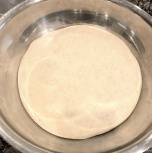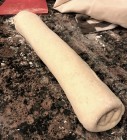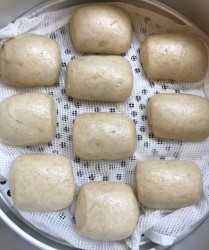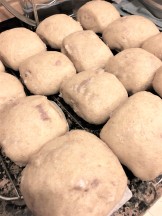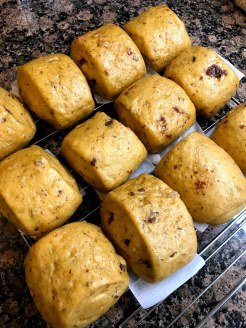The sourdough artisan bread loaf and steam buns use the same ingredients, but the difference that creates the opposite texture — crust & crumb vs. smooth & soft — is the level of hydration or the amount of water that is mixed into the dough. For the steam buns, the best hydration level is between 50-60% (percentage of flour), the less water the more firm the buns, which are the type of steam buns made in the Sangdong region. With more water, it is closer to the steam buns found in Taiwan, fluffier, and QQ (chewy).
The two hurdles (for me) in making good buns are making sure that the steamer does not collect too much condensation during cooking, too much water dripping on the buns from the steam ruins the smooth surface of the buns, resulting in an undesirable tough surface. Secondly, to be very patient after shaping the dough, to give it enough time to raise for the second time and to include additional fermenting over a warm pot of water before steaming.
Making steam buns with sourdough, unlike using yeast, requires a lot of patience and waiting.
Ingredients:
120 grams 100% hydration sourdough starter (levain)
540 grams all-purpose flour or bread flour (option: 10-30% whole wheat flour)
240 ml of water (option: substitute all – 1/2 of water to milk)
30 grams sugar (add more sugar for sweeter buns)
12 ml of oil
pinch of salt
parchment paper
Steps:
- In a stand mixer bowl, loosen the starter with the water, then add in the flour and mix with the hook till all ingredients are fairly well combined.
- Rest the mixture for 30 minutes. (The flour-only environment is better for the starter to ferment and do its magic.)
- Add in the sugar, oil, salt, and mix for 8-10 minutes until the dough is smooth and not sticky. The surface of the mixing bowl should be very clean and all the dough should be stuck to the hook.
- For bulk fermentation leave the dough to rise to about 20-30% in a warm place, it will take about 2-4 hours, make sure to cover the dough well so it does not dry out.
- Next, de-gas and shape the dough. There are endless ways to shape the dough but my favorite method is to gently move the dough onto a work surface, cut the dough in half, place one half under a towel to keep moist and start shaping the remaining half. First, gently rolling the dough with a rolling pin into a square or rectangle to about 1/2 cm (1/3 inch), then take one of the sides and start rolling into a long loaf. Once rolled, cut the loaf into about 7 cm (3 inches) of equal-sized buns. Gently roll each small buns to shape and place on a parchment paper just enough to cover the bottom of the bun. And then place the buns into the steamer for a second fermentation. Repeat the same for the other half of dough. Make sure to cover the buns with the steamer lid.
- The second fermentation should be 1-1.5 hours. It should increase in size by about 30-40%. It may be difficult to tell how much the dough has risen so use the finger test by pushing gently on the surface of the dough with your finger and make a slight indent and if it does not bounce back or if the indent remains, it is ready. (If the bounces back or the indent is no longer visible it means that the dough can ferment more and increase its size.)
- Heat up the water for the steamer to about 40C (104F) and turn off the heat. Place the steam with the buns inside over the warm water and wait for 20 minutes for the final fermentation. Make sure the lid is still on.
- Finally, ready to steam. I like to place a towel underneath the lid to catch the condensation from the steam to prevent it from landing on the buns. (Excess water on the buns may result in a bumpy rough surface.)
- Start steaming at high heat once the water starts to boil turn the heat to medium and steam for 15 minutes.
- Once steaming over, turn off the heat but DO NOT open the lid and let steamer cool down with the lid on for 5-8 minutes. It is important not to open the lid right away to prevent the risen buns from collapsing when the cold air rushes into the steamer.
- Once cooled move the buns onto a rack to cool completely.
- The buns will keep in the fridge for 3-4 days, it also can be frozen. The best way to heat up the buns is to place them in the steamer for 10-15 minutes.
Step by step process:
Other steamed buns we made:



